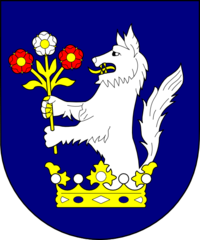| House of Révay | |
|---|---|
 | |
| Country | Kingdom of Hungary |
| Founded | early 13th century |
| Founder | Jakab de Ryva |
| Titles |
|
| Estate(s) | Szklabinya, Blatnica, Mosóc |
| Cadet branches | Révay de Trebosztó |
The Révay family was a Hungarian noble family, who owned estates in Turóc county, the Kingdom of Hungary (Turiec region in today's Slovakia) until the early 20th century. Their property included i.a. the Rococo-classical manor house in Mošovce, the so-called Old Manor house demolished in the middle of the 20th century, the Noblemen's Mansion and the park in Mošovce, a castle in Blatnica, lands and a castle in Sklabiňa, as well as a manor-house with a park in Turčianska Štiavnička.
Family history

The Révay family has been known since the 13th century. The first known ancestor of the family was called Comes Jakab (Count Jakab) in the early 13th century. The main estates of the family were situated in the region of Syrmia until the Ottoman occupation of southern Hungary. In 1556 and 1635 the family was promoted to Barons and on 17 June 1723 to Counts. The coat of arms of the Masters de Reva, which can be seen at the façade of their manor house, is composed of a wolf Tenné growing from a crown of Or, holding three roses. Mošovce became the property of the Révay family in 1534, six years after the donation of the King of Hungary, Ferdinand I, Holy Roman Emperor. The last member of the family, who resided in Mošovce, was count Ferenc Révay. Today the descendants of the family live in Trnava, Bratislava, Graz as well as in Hungary. The last letter of the name is sometimes "i" instead of "y" in some printed versions or as an affair of modernization in the late 19th century Kingdom of Hungary.
After World War II, the property of the Révay family in Turiec was nationalized. In 1993, the niece of Ladislav Révay, the last of the counts, filed a request for the restitution of their property. The request ended up in court as the Révay family and the state had differing opinions as to the extent of their claim. In 2001 the restitution claim of the Révays was rejected by the Constitutional Court of the Slovak Republic. 5 years later, however, the European Court of Human Rights in Strasbourg issued a ruling allowing the matter to proceed, thus opening a possibility for a reconciliation of both parties. This resulted in a financial compensation of the state for the husband and wife of Ladislav Révay's niece (who died in 1995) in the amount of SKK 150 million (just under 5 million EUR).
In Sweden, the family is considered part of the unintroduced nobility.
See also
Gallery
-
 Count Ferenc Révay, the last member of the Révay family, who lived in Mošovce. Picture approx. from 1910.
Count Ferenc Révay, the last member of the Révay family, who lived in Mošovce. Picture approx. from 1910.
-
 The grave of Count Ferenc Révay in the woods of Mošovce
The grave of Count Ferenc Révay in the woods of Mošovce
-
 Coat of arms of the Révay (left) and Szunyogh families
Coat of arms of the Révay (left) and Szunyogh families
-
 Initials of Count Ferenc Révay in the gate of the manor-house in Mošovce
Initials of Count Ferenc Révay in the gate of the manor-house in Mošovce
See also
Further reading
- BEŇOVSKÝ, J. a kol.: Mošovce v premenách času. Martin: Osveta, 1984. 304 pp.
- LIPPAN, M. a kol.: Mošovce. Banská Bystrica: Stredoslovenské vydavateľstvo, 1971. 405 pp.
- REŤKOVSKÝ, P.: The Tourist Guide of Sites in Mošovce. Mošovce: Obecný úrad Mošovce, 2004. 38 pp., ISBN 80-969156-1-4
- TATÁR, J.: Mošovce v historickej, kultúrnej a prírodnej mozaike. Mošovce: Obecný úrad Mošovce, 2003. 124 pp., ISBN 80-968976-0-8
- TATÁR, J.: Živý poklad (Povesti z Mošoviec). Mošovce: Obecný úrad Mošovce, 1994. 64 pp. ISBN 80-967232-0-0
References
- Hamish M, Scott (1995). "Scientific Migration from Eastern Europe". The European Nobilities in the Seventeenth and Eighteenth Centuries: Northern, Central and Eastern Europe. Longman. p. 336. ISBN 978-0-582-08071-3.
- "Révay - Lexikon ::".
- Monika Tódová (2008-09-23). "Štát odškodní šľachticov". Retrieved 2008-09-23.
External links
| Titled unintroduced nobility of Sweden | |
|---|---|
| Princely | |
| Ducal | |
| Marquisal | |
| Comital | |
| Baronial | |
| Families that have been included in Kalender öfver i Sverige lefvande ointroducerad adel (1886–1899), Sveriges ointroducerade adels kalender (1912–1944) and/or Kalender över Ointroducerad adels förening (1935–) | |